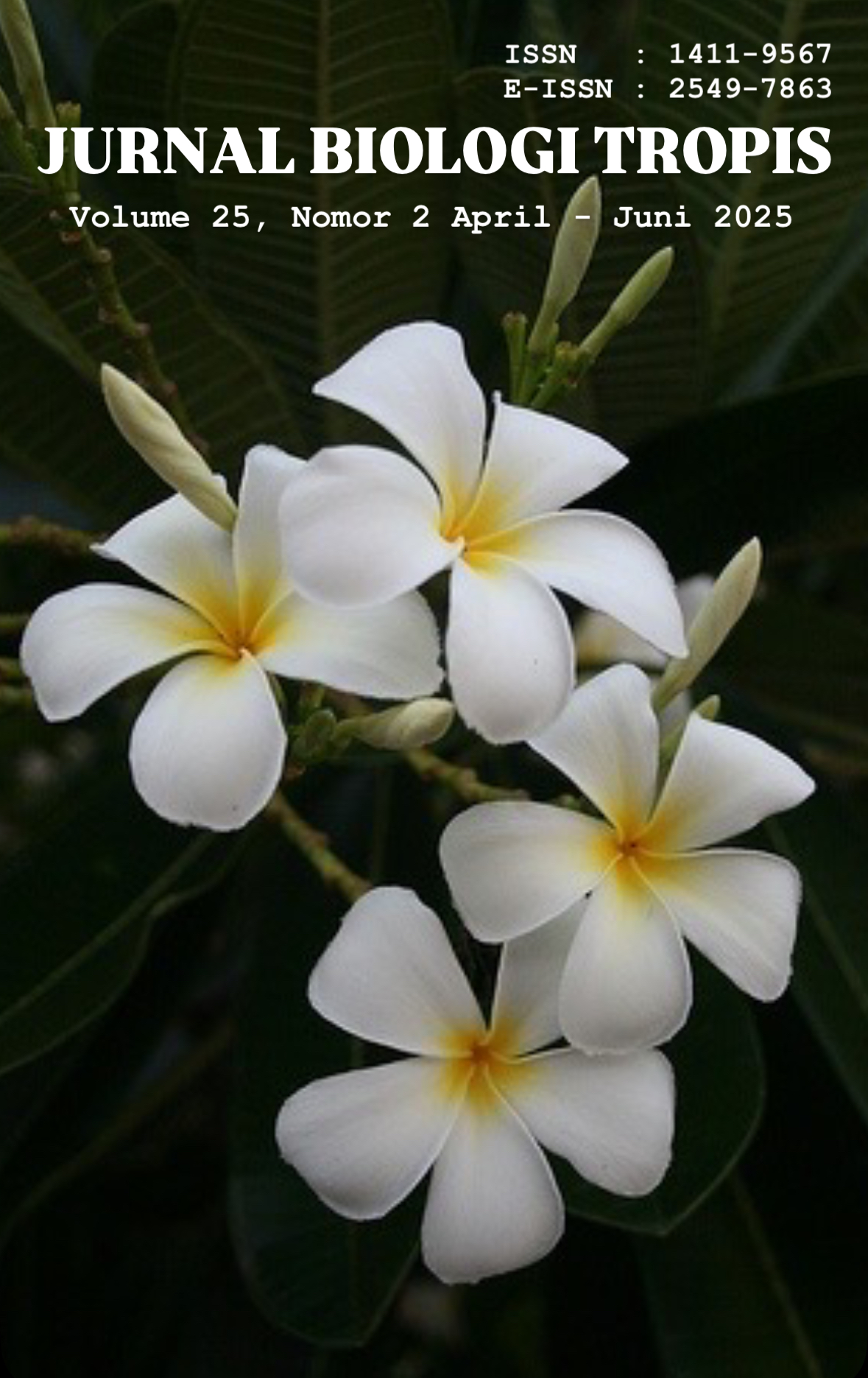Utilization of Forest Plants as Spices by Women in Benua Kencana Village, Sintang
Authors
Ellen Putri Yumita , Gusti Eva Tavita , Fathul Yusro , Yeni MarianiDOI:
10.29303/jbt.v25i2.8696Published:
2025-04-22Issue:
Vol. 25 No. 2 (2025): April-JuniKeywords:
ethnobotany, forest spice plants, Use value, Fidelity level, Women's roleArticles
Downloads
How to Cite
Downloads
Metrics
Abstract
Spices have many benefits, especially as additional ingredients in cooking, traditional medicine and raw materials for the pharmaceutical and cosmetic industries. This study aims to identify forest plant species utilized as spices by women in Benua Kencana Village, Sintang Regency, and to understand their usage and processing practices. The research employed a survey method with semi-structured interviews involving 161 female respondents. Data analysis was conducted using Use Value (UV) and Fidelity Level (FL) to assess the degree of utilization and community trust in forest spice plants. The results indicate that the utilized plant parts include leaves, stems, fruits, and bark, serving various functions such as flavor enhancers (sweet, sour, and aromatic), tenderizers, preservatives, and neutralizers in cooking. The plants with the highest UV values (1.00) were Garcinia xanthochynus (asam kandis) and Pycnarrhena cauliflora (sengkubak), while those with the highest FL values (100%) included Pycnarrhena cauliflora (sengkubak), Eryngium foetidum (sumpak laut), Garcinia xanthochynus (asam kandis), Baccaurea motleyana (rambai), and Baccaurea angulata (benit). Women play a dominant role in the management and utilization of these spices, particularly in selecting, processing, and passing down knowledge about their uses. This study highlights the importance of documenting and preserving local knowledge to support food security and the conservation of natural resources.
References
De Almeida, C. D. F. C. B. R., Ramos, M. A., Silva, R. R. V., De Melo, J. G., Medeiros, M. F. T., Arajo, T. A. D. S., De Almeida, A. L. S., De Amorim, E. L. C., Alves, R. R. D. N., & De Albuquerque, U. P. (2012). Intracultural variation in the knowledge of medicinal plants in an urban-rural community in the Atlantic Forest from Northeastern Brazil. Evidence-Based Complementary and Alternative Medicine, 2012. https://doi.org/10.1155/2012/679373.
Faqih, A. (2020). Pemberdayaan Perempuan Melalui Pemanfaatan dan Penataan Pekarangan. ABDIMAS GALUH, 2(1), 1–11.
Juira, N., Lovadi, I., & Linda, R. (2015). Pemanfaatan Tumbuhan Sebagai Penyedap Rasa Alami Pada Masyarakat Suku Dayak Jangkang Tanjung Dan Melayu Di Kabupaten Sanggau. Protobiont, 4(3), 74–80.
Maia, A. C. P., Ferreira, E. D. C., De Lucena, C. M., Souza, A. D. S., Da Cruz, D. D., & De Lucena, R. F. P. (2021). Comparing ethnobotanical knowledge of medicinal plants between community health workers and local experts in the “mata da paraíba” zone, northeastern brazil. Biodiversitas, 22(12), 5606–5616. https://doi.org/10.13057/biodiv/d221257
Nabila, A. P., Lintang Zahira, K., Deadonita, V., Dhiaulhaq, R., Tawakkal, D. I., Prabu, B., Vladimir, M., Rafi, A., Adhillah, N., & Risqullah, N. (2024). Mendeskripsikan Cita Rasa dan Aroma Bumbu dan Rempah Rendang yang Digunakan di Beberapa Restoran Padang di Sekitar UNNES. Jurnal Potensial, 3(1). http://jurnalilmiah.org/journal/index.php/potensial
Najiah, P. S. A., Hernawati, D., & Meylani, V. (2021). Efektivitas Hand Sanitizer Alami Ekstrak Daun Cengkeh (Syzygium aromaticum (L.) Merr. & L.M.Perry) terhadap Methicillin-Resistant Staphylococcus aureus. Journal of Natural Sciences, 2(3), 85–94. https://doi.org/10.34007/jonas.v2i3.145
Ncube, S. F., Ndagurwa, H. G. T., Mundy, P. J., Sibanda, S., & Dlodlo, M. (2022). Ethnobotanical knowledge and use-value of Harpagophytum (Devil’s claw) in Matabeleland, Zimbabwe. South African Journal of Botany, 144, 134–144. https://doi.org/10.1016/j.sajb.2021.08.015
Novriyanti, N., Nursanti, N., & Wulan, C. (2021). Short Communication: Do women have a piece of traditional knowledge on medicinal plants? A case study around Jambi Urban Forest, Indonesia. Asian Journal of Ethnobiology, 4(2), 115–119. https://doi.org/10.13057/asianjethnobiol/y040206
Nuraeni, S., Supangkat, B., & Iskandar, J. (2022). Kajian Etnobotani Tanaman Rempah sebagai Bumbu, Obat dan Kias. UMBARA; Indonesian Journal of Anthropology, 7(1), 27–38. https://doi.org/10.24198/umbara.v7i1.39395
Phatlamphu, N., Saensouk, S., Saensouk, P., & Junsongduang, A. (2021). Ethnobotany of edible plants in Muang District, Kalasin Province, Thailand. Biodiversitas, 22(12), 5432–5444. https://doi.org/10.13057/biodiv/d221226
Pramesthi, D., Ardyati, I., & Slamet, A. (2020). Potensi Tumbuhan Rempah dan Bumbu yang Digunakan dalam Masakan Lokal Buton sebagai Sumber Belajar. BIODIK, 6(3), 225–232. https://doi.org/10.22437/bio.v6i3.9861
Reyes-García, V., Fernández-Llamazares, Á., Aumeeruddy-Thomas, Y., Benyei, P., Bussmann, R. W., Diamond, S. K., García-del-Amo, D., Guadilla-Sáez, S., Hanazaki, N., Kosoy, N., Lavides, M., Luz, A. C., McElwee, P., Meretsky, V. J., Newberry, T., Molnár, Z., Ruiz-Mallén, I., Salpeteur, M., Wyndham, F. S., … Brondizio, E. S. (2022). Recognizing Indigenous peoples’ and local communities’ rights and agency in the post-2020 Biodiversity Agenda. Ambio, 51(1), 84–92. https://doi.org/10.1007/s13280-021-01561-7
Robi, Y., & Masitoh Kartikawati, S. (2019). Etonobotani Rempah Tradisional di Desa Empoto Kabupaten Sanggau Kalimantan Barat (Vol. 7, Issue 1).
Saadi, H., Jafari, S., & Karimi, S. (2023). Factors affecting the intention of Iranian rural women to use medicinal herbs. BMC Complementary Medicine and Therapies, 23(1). https://doi.org/10.1186/s12906-023-03964-3
Sari, R. P., Yusro, F., & Mariani, Y. (2021). Medicinal Plants Used by Dayak Kanayatn Traditional Healers in Tonang Village Sengah Temila District Landak Regency. Jurnal Biologi Tropis, 21(2), 324–335. https://doi.org/10.29303/jbt.v21i2.2557
Sijabat, E., Dwi Sayekti, W., & Lestari, D. A. H. (2021). Pengambilan Keputusan dan Pola Pembelian Bumbu Giling Pada Rumah Tangga di Kota Bandar Lampung. Jurnal Ilmu Ilmu Agribisnis: Journal of Agribusiness Science, 9(1), 25–32.
Suryaningrum, D. A. S., Rizki Puspita Dewanti, Rysca Indreswari, & Ina Marwantina. (2024). Consumer Preferences on Processed Herbs and Spices Products of SMEs in Sukoharjo. Jurnal Informasi Dan Teknologi, 6(2), 116–122. https://doi.org/10.60083/jidt.v6i2.537
Torres-Avilez, W., Medeiros, P. M. De, & Albuquerque, U. P. (2016). Effect of Gender on the Knowledge of Medicinal Plants: Systematic Review and Meta-Analysis. Evidence-Based Complementary and Alternative Medicine, 2016, 12–15. https://doi.org/10.1155/2016/6592363
Wahyudi, Pulungan, D. R. A., Syahfitri, D., & Salsabila, R. F. (2024). Daun Salam (Syzygium polyanthum) Rempah Khas Indonesia dengan Berbagai Manfaat Farmakologi: Literature Review. Indonesian Journal of Pharmaceutical Education (e-Journal), 4(3), 2775–3670. https://doi.org/10.37311/ijpe.v4i3.28452
Wardhani, H. (2021). Potensi Tumbuhan Rempah dan Bumbu di Kabupaten Sintang Kalimantan Barat. Edumedia: Jurnal Keguruan Dan Ilmu Pendidikan, 5(2), 70–73.
Yanti, H., Advinda, A., & Tavita, G. E. (2023). Pemanfaatan Tumbuhan Rempah dan Bumbu Tradisional oleh Masyarakat Desa Sebuduh Kecamatan Kembayan Kabupaten Sanggau. Jurnal Hutan Lestari, 11(2), 432–450.
Yusro, F., Mariani, Y., & Wardenaar, E. (2021). The Utilization of Medicinal Plants to Overcome Gastric Disorders by The Dayak Muara Tribe in Kuala Dua Village, Sanggau Regency. Jurnal Biologi Tropis, 21(2), 416. https://doi.org/10.29303/jbt.v21i2.2638
License
Copyright (c) 2025 Ellen Putri Yumita, Gusti Eva Tavita, Fathul Yusro, Yeni Mariani

This work is licensed under a Creative Commons Attribution 4.0 International License.

Jurnal Biologi Tropis is licensed under a Creative Commons Attribution 4.0 International License.
The copyright of the received article shall be assigned to the author as the owner of the paper. The intended copyright includes the right to publish the article in various forms (including reprints). The journal maintains the publishing rights to the published articles.
Authors are permitted to disseminate published articles by sharing the link/DOI of the article at the journal. Authors are allowed to use their articles for any legal purposes deemed necessary without written permission from the journal with an acknowledgment of initial publication to this journal.


























